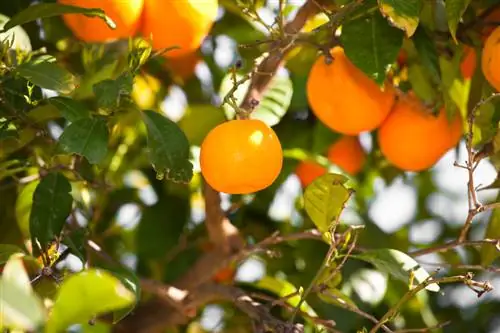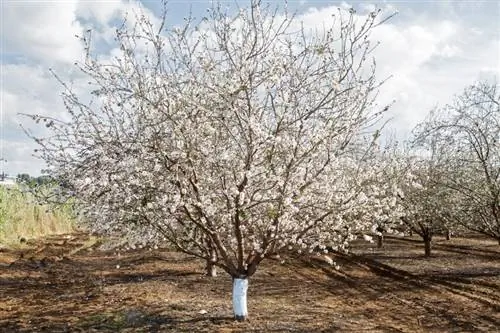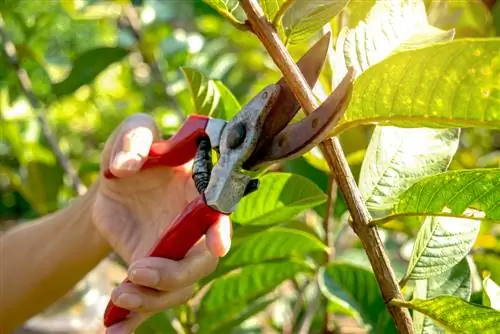- Author admin [email protected].
- Public 2023-12-16 16:46.
- Last modified 2025-01-23 11:20.
In the home of the orange trees it is warm, sunny and also very humid. Oranges come from the subtropical climate zone and are still grown even in the humid tropics. Oranges cultivated in the Mediterranean region need additional watering because the Mediterranean climate is actually too dry.

How do I optimally care for my orange tree?
How do you properly care for an orange tree? Water regularly and evenly, preferably with low-lime water, fertilize the growth (ratio 3:1:2), watch out for pests, cut if necessary and overwinter at temperatures of 5-15 °C.
When and how often does the orange tree need to be watered?
Regular and even watering with low-lime water is particularly important during the growing season; It is best to water once a day. In winter, when there is little frost-free hibernation and there is less light, the orange tree needs significantly less water - one watering session per month is enough.
How do I fertilize correctly?
Oranges - just like all other citrus trees - need a lot of nutrients during the growing season. For potted plants, the first fertilizer should be given at the beginning of budding in spring (usually in March). Nutrients are then regularly supplied until September. Fertilization can be done with a liquid fertilizer, which is applied once or twice a week with the irrigation water from the start of budding. The fertilizer should ideally contain a nutrient mixture with nitrogen / phosphorus / potassium in a ratio of 3:1:2.
What to do if the leaves change color?
If the leaves of the plant slowly turn more and more yellow, this could be due to a pest infestation, root rot, a lack of water or a lack of nutrients. The beautiful deep green leaf color only comes about through sufficient fertilization with nitrogen. Furthermore, watering with calcareous water can block nutrient absorption, which is why you should always water with low-lime water (e.g. rainwater).
Which pests can occur and what can I do about them?
On the orange tree, especially if it is kept indoors, occurrences are particularly common
- Scale insects
- Aphids
- mealybugs and mealybugs
- Spider mites
- as well as various fungal diseases.
Treatment is carried out with a fungicide or, in the case of pest infestation, with potash soap (€7.00 on Amazon).
What to do if the orange tree drops its leaves?
A complete loss of leaves during frost-free wintering is almost always the result of a location that is too warm and/or too dark. Another reason may be that the plant was once kept too dry, so that the leaves have already curled up on the outer edge. After thorough watering, all of the leaves are often thrown off, but the tree usually sprouts again.
When and how do I cut best?
In principle, orange trees can be cut at any time. For large potted plants that are to be moved from their summer quarters to their winter quarters, we recommend prior topiary pruning. Remove any branches that do not fit into the desired shape (usually a spherical crown). In addition, branches that grow into the interior of the crown are removed at the same time and shoots that are too dense or whorled are isolated. In addition, all dead wood should be cut out.
Overwintering oranges
The amount of light available in German regions in winter is not sufficient to allow an orange to continue growing he althily. If you want to overwinter your orange tree in your apartment, please note the following: Choose the coolest room for this. If the room temperature is higher than 12 °C for at least 12 hours a day, plant lamps must be installed as additional lighting. The fewest problems arise when the orange trees grown in pots are overwintered at temperatures of around 5 °C at night and up to 15 °C during the day.
Tips & Tricks
So-called trimming is much gentler on the orange tree than radical topiary. Simply remove the tips of the new shoots as soon as they have reached the desired length.






